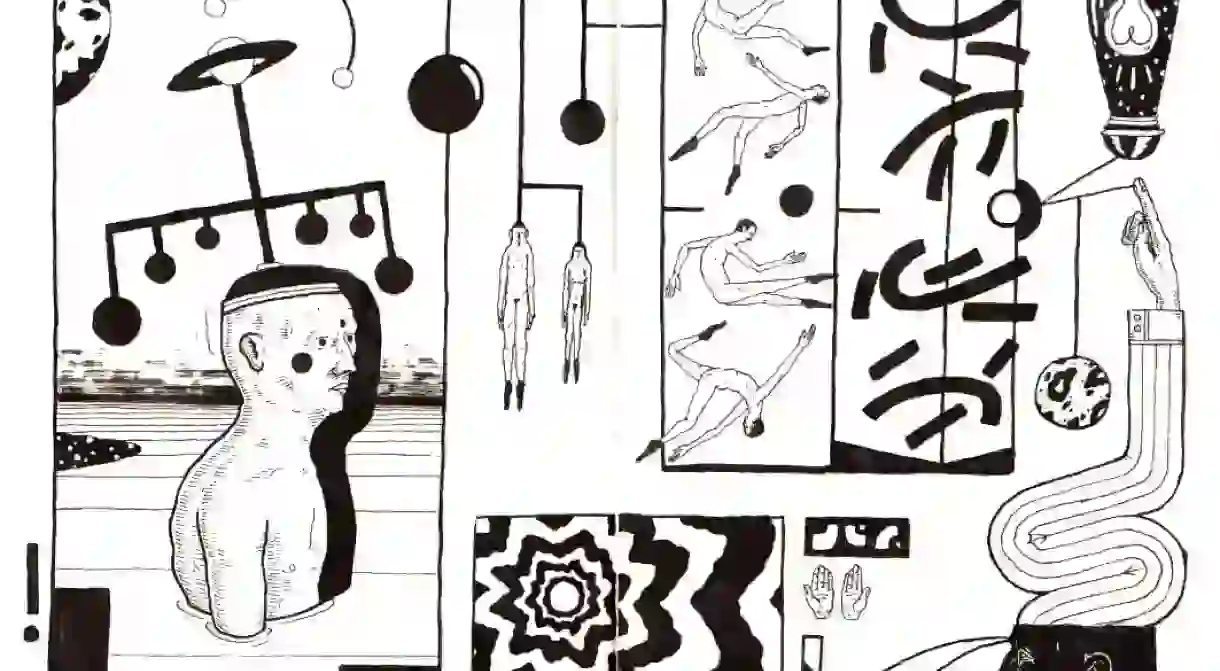Interview: A Glimpse Into the Surrealist Mind of Artist Hagen Schönfeld

Based in Berlin, the young artist and illustrator Hagen Schönfeld creates work inspired by his otherworldly imagination and infused with his own sense, creative, childlike wonder.
Hagen plays with surreal motifs that include anything from flying spaceships and staircases leading to outer space to cacti minimally positioned with melting sunsets to bubblegum brains, bananas and floating body parts. His dreamlike narratives are brought together and balanced by a strong sense of graphic symmetry and composition.
We sat down with the young artist and picked his brain about his fresh and fantastical style, his artistic influences, how boredom became the surprising catalyst in nurturing his talent and what he loves most about living in Europe’s crazy, creative capital.
Culture Trip: Tell us a little bit about how you got into making art – when did you start drawing, and where did the skill come from?
Hagen Schönfeld: I’ve always drawn, but it only became a passion around four years ago. After finishing school, I went travelling for a long period, and towards the end of the trip, I had a lot of spare time. Out of boredom, I would spend whole days only drawing, which I hadn’t done before. After that experience, it became very clear to me that this was what I wanted to pursue. I have drawn almost every day since then.

CT: Tell us about your artistic alias, ‘Evol Corduroy’.
HS: The name evolved quite randomly. I used to draw ‘EVOL’ as a graphic element and signature on my drawings, which is ‘love’ backwards. I then added ‘Corduroy’ not only because I love the fabric, but also mainly because I love the word itself, how it sounds and looks – though I’m not sure if I will keep this alias as I haven’t decided yet if I want to have an alias at all or use my actual name.

CT: With spaceships, cacti and floating body parts, your work feels both cosmic and surreal. Can you tell us a bit more about these motifs and expressions in your work, and what inspires the imagery we see?
HS: It usually comes from an urge to draw. It is inspired by my surroundings and situations I find myself in. An idea pops up in my head from something that I see or imagine. I transfer it to paper and then add my own motifs. There’s a lot of imagery that reoccurs in my work, often because I love it graphically and not because of a potential meaning. I assume there is potential meaning in all of them, which everyone can find for themselves. I approach it as an exploration of graphic relations.
CT: Would you identify yourself as a surrealist?
HS: I assume so. Yes.

CT: Is there a particular message you are trying to convey in your work?
HS: No. But I guess that unconsciously in all my work there is always a childish sense of wonder towards everyday life.
CT: Who and what are some of your artistic influences (other painters and artists/movements/philosophies, etc.)?
HS: There are a lot of contemporary painters and illustrators that inspire me. These are mainly people who have a sense of wonder, surrealism and particular attention to graphic design and composition. I currently follow the work of Cristina Daura, Aec Interesni Kazki and Keith Rankin, among other talented artists. I am also inspired by Tadanori Yokoo, Hieronymus Bosch, Hannah Höch and Giorgio de Chirico. I as well love scientific illustrations of fauna and flora, the human body and space.

CT: What role does music play when making art, if any?
HS: Music is my most loyal companion. I always listen to it while drawing. A lot of album art inspires me, and luckily, lately, I have been getting more involved in musical projects.
CT: What techniques are you currently exploring?
HS: I tend to create some challenges or tasks for myself in order to get out of my comfort zone. During a recent trip to Spain as I was sitting in the car, I simply placed the pen on the paper and let the bumpy road guide the line, which led to some weird and abstract drawings. I also enjoy playing games [such as Exquisite Corpse] with friends who do not usually draw. Doing these things opens up my range and generally brings back a playful approach towards my work.

CT: What do you love most about living in Berlin?
HS: I love Berlin’s freedom of expression and its accumulation of weird characters from all over the world. There is a lot of creativity here.
CT: Name three of your favourite places/things to do in the city.
HS: Sitting on the train and drawing peculiar people, going to my favourite neighbourhood bakery, Anstalt (Prenzlauer Berg), and checking out a movie at the cosy, indie B-Ware Ladenkino.


CT: Any projects you’re currently working on, and what does the future hold for you?
HS: I am working as an art director for a small record label (Domesticated). I am working on a comic, and I just started a three-year programme at the public arts school in Berlin.













